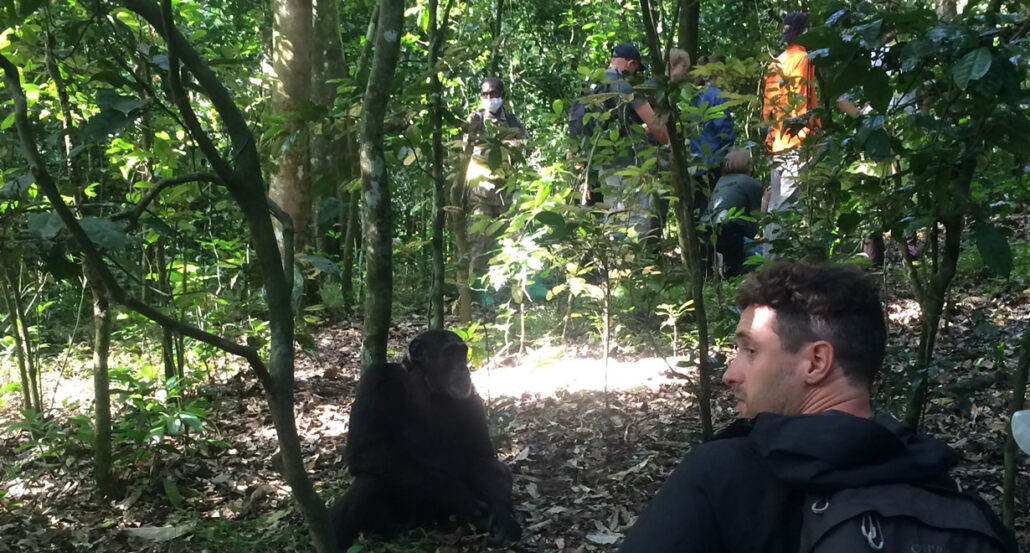Activities & Attractions In Kibale Forest National Park
Activities & Attractions in Kibale Forest national Park include Chimpanzee tracking, Chimpanzee habituation, Bigodi Wetland Sanctuary Nature walk, Nocturnal forest walks, Birding, Crater lakes safari, Amabere ganyina Mwiru Visit etcetera.

Kibale Forest National Park which measures an area of 790 km2 is set in between Kabarole and Kamwenge districts in Western Uganda. The Afromontane and tropical forest harbors 13 primate species, with chimpanzees having the largest population and the key attraction in the Park. While other primates besides the 1500 individual chimpanzees include L’Hoest Monkeys, Black and white Colobus Monkeys, Grey checked Mangabeys, Olive baboons, Olive baboons, Vervet Monkeys, Bush babies, Mammal species. Kibale Fotrest national park is not only a home to the primates, but also known for the hard to seem mammals including Elephants, Buffaloes, Sitatunga’s, wild dogs, bush pigs, duikers as well as a large number of bird species like the great blue Turaco, collard Apalis, crown eagles, Black Bee eater among others, not forgetting the numerous butterflies.
Kibale Forest national Park provides various key attractions & activities (things to do) in Kibale Forest national Park, which might make your safari, a memory for a lifetime. These activities include
Detailed Guide of Attractions & Activities In Kibale National Park
Chimpanzee tracking
Chimpanzee tracking tops other activities in Kibale Forest National Park, which is the major reason for the Park conservation. This park has a wide population of chimpanzee individuals amounting beyond 1500, distributed between 13 communities, lout of which 5 have been habituated. 3 out of 5 habituated communities including research ngongo, kanyawala & sebitory are for research, whereas the other including Kanyantale (120 individual chimps) is free for tracking & kisongi (about 80-100 individuals) is for habituation.
Chimpanzee Tracking cannot just happen, but rather follows a gradual process; from obtaining a chimpanzee tracking permits, which is done prior to the tracking date, adhering to the chimpanzee trekking & tracking rules and regulations, then finding the chimpanzees in their natural home, after a 2-6 hours trek, with an inclusive 1 hour of face to face contact with the Chimpanzees.
Each chimpanzee tracking and habituation permit costs 250 USD and 300 USD respectively.
Chimpanzee Habituation in Kibale Forest National Park
As early mentions, only 1 out 5 habituated Chimpanzee community-Kisongi is allowed for chimpanzee habituation experience. Each chimpanzee habituation permit costs 250 USD per person per day. This inspiring experience is restricted to 4 individuals per tracking group, who will follow the chimpanzees closely and observe them for a maximum of 4 hours.
All trackers have a memorable chance to watch chimpanzees feed, build their nests, hunting mating, feed their young ones, playing and resting.
Nocturnal Night Forest Walks
This night forest walk is truly an interesting activity which allows you to explore the Park at night. It gives you the best chance to look for nocturnal primates in the dark, as well trained guide leads you through the forest with light torches being the main source of the light. Nocturnal Night forest walks usually start at 7:00pm, when all participants set off. This offers great encounters of nocturenals like Hurax, crickets, night jars, bush babies, pottos, Galagos among others.
Bird Watching in Kibale Forest national Park
Kibale forest National Park is an ideal bird watching destination, for bird enthusiasts, This ideal bird haven protects more than 370 recorded bird species, including the non recorded bird which are endemic to the Forest.
Birding is best done early every morning or in the Late evenings with an experienced and fully skillied guide, who will lead you to the bird sights to spot birds including Tinker bird, The Green Breasted Pitta, Chestnut Winged Starling, White Naped Pigeon, African Pitta, Tiny Sunbirds, Scarlet chested sunbird, Woodland Wobbler, crowned eagle, African Grey Parrot, and Joyful Greybull among others.
Bigodi Wetland Sanctuary: Set in Magombe swamp, Bigodi wetland sanctuary is located outside kibale Forest National Park, just 6km from Kanyanchu Visitor center. Bigodi nature walks are directed by trained and experienced leaders from the surrounding communities who are the sole beneficiaries from the wetland. Because it regarded as the major ecotourism enterprise.
Bigodi Wetland sanctuary, is equally birder’s paradise, consisting over 138 bird species including the great blue Turaco, purple breasted sunbird, African Pitta, Black-capped apalis, weavers, cuckoos, hornbills, beet eaters, while other primate spotted red colobus monkeys, vervet monkeys, blue monkeys. The swamp also has mammals such as Mongoose, warthogs, bush bucks among others, as well as many butterflies.
Cultural experience
Kibale Forest National Park is surrounded by good and hospitable cultural communities who are worthy visiting. These communities are gathering into small cultural groups, commonly known as Kibale Association For Rural Environment Development. Visiting the communities, gives you great opportunities to learn about their ways of leaving, traditional activities, cultural dances and what they eat in their day to day life.
Crater lakes Tour
Crater lakes tour is one other key activity that can be included in every travelers itinerary, that can be done before or after visiting Kibale forest National Park. The crater lakes offers great opportunities to hike up the steep slopes which later turn out to be eye catching with impressive scenery. You will be view the crater lakes from a bird eye’s view. While at the top, you can also enjoy the spectacular scenic view of the magnificent Rwenzori mountain ranges, breathtaking Kibale forest.
Amabere Ganyina Mwiru Visit
The Amabere Ganyina Mwiru comprises of a number rocks enclosed in a cave, located a few meters from Nyakasura school in Fort Portal-Kabarole District. Visiting these rocks takes you through magnificent water falls which welcomes you. The Amabere Ganyina are believed to have existed as a result of stalagmites and stalactites formation. Yet the Batooro have a strong belief attached to it. They believe that they belonged to a mutooro young girl whose breast were cut at attender age, by how own father, as a result of refusing to get married to a suiter her father had chosen for her.